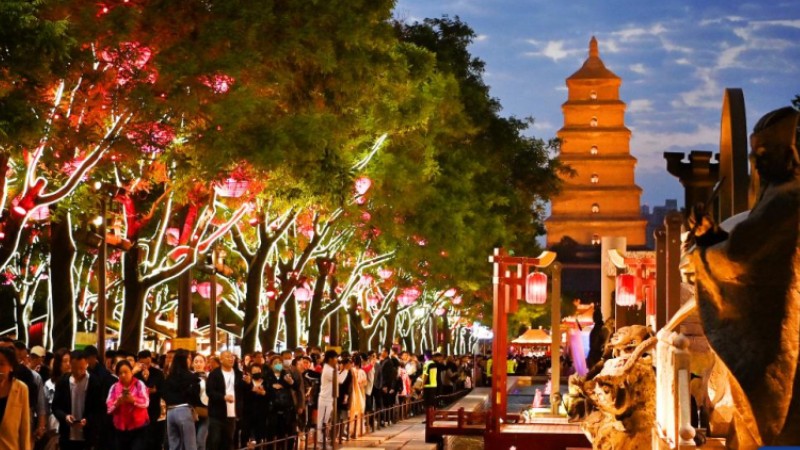Young Chinese lead craze for museums, antiquities
BEIJING, May 17 (Xinhua) -- Search the internet for "wanghong wenwu" -- or "internet famous cultural relics" -- and you find photos and emojis of fun-looking antiquities from museums across China, often made funnier by young people with wild imaginations.
For instance, one exhibit from the Shanxi Museum is a bronze wine vessel in the shape of an owl, dated to as early as the 16th century B.C. Netizens have dubbed it "angry bird" due to its resemblance to a chubby Finnish video game character of that name. Meanwhile, a bronze figure unearthed at the Sanxingdui Ruins site is likened to the Japanese animation character Ultraman.
Behind these widely shared internet memes is a growing interest among young Chinese people in historical artifacts, and their newfound enthusiasm for visiting museums in general. They have become the driving force in a growing fascination with museums across the country.
The craze was on display during the five-day May Day holiday this year. Across the country, over 6,000 museums received more than 50 million visits, a record high, according to preliminary figures from the National Cultural Heritage Administration.
The Hubei Provincial Museum, located in the central Chinese city of Wuhan, attracted over 20,000 visits a day during the holiday. Its exhibition of the sword of Goujian, drew long lines of youngsters hoping to see an authentic piece of the legendary King's sword, a treasure dating back 2,500 years.
Tian Xing, a college student majoring in computer science traveled from Hunan Province, set aside an entire day to visit the Hubei Provincial Museum. "Every time I travel to a new city, visiting local museums is my first choice," he said. "Museums are like a window, allowing me to see how ancient men lived and how wise they were."
According to data from the Hubei Provincial Museum, from 2021 onwards, young people aged below 30 have made up over 60 percent of the total number of visitors. The 18-24 age group accounts for 39.96 percent of visitors, making it the largest.
At least 80 percent of visitors to the Luoyang Museum of Ancient Tombs in central China's Henan Province were aged below 35, according to Zhang Jianwen, the museum's vice curator.
Zhang believes that young people enjoy visiting historical museums due to their growing curiosity about and fondness for cultural relics, ancient history and traditional culture.
"To put it in a broader perspective, the younger generations' identification with traditional Chinese culture and their cultural confidence in general are on the rise," said Zhang.
More and more young people have gone beyond merely snapping photos and "checking-in" at exhibitions, and are now nurturing a true appreciation for the historical and cultural value of the treasures on display.
Yang Yang, a 30-year-old IT industry worker, traveled from the city of Xingtai, Hebei Province, to Luoyang for a four-day tour dedicated to museums. As someone who was "quite interested in history and culture from early childhood", he cherished the opportunity to broaden his horizons in the historic city of Luoyang.
"Through cultural relics, I learn about the everyday lives, rituals and social systems of ancient people, and even the boom-and-bust cycles of imperial dynasties," Yang said.
Sharing his feelings about the tour, Yang said he was most impressed by the fresco exhibitions in the Luoyang Museum of Ancient Tombs. "It's like a panorama of ancient life, vividly showing people going out, drinking at banquets, playing musical instruments, dressing up and putting on make-up," he said.
Museums have also done their utmost to woo the younger generations, providing a greater range of attractions. Many cater specifically to the preferences of youngsters, including laser shows, giant-screen video shows, night tours, stamp-collecting museum passports and other creative souvenirs.
Even the millennium-old artifacts have found their ways of relating to young people.
For instance, in 2020, the Henan Museum launched a creative souvenir named the "archeological blind box", which allows buyers a hands-on experience of excavating an unspecified "antiquity" with a miniature Luoyang shovel, a traditional Chinese tool for archaeological digging.
Tan Ping, director of Art Exhibitions China, a government agency affiliated to the National Cultural Heritage Administration, said that today's youngsters are well-off, patriotic and ready to explore new things. These traits have spurred museums into experimenting with the fusion of tradition and new trends, using modern ingenuity to present history and civilization, said Tan.
Photos
Related Stories
- Diversified museums empower sustainable development, better lives
- People visit museums in Xi'an, NW China's Shaanxi
- Digital tech restore relics in museum in E China's Hangzhou
- Fujian Museum to serve as China's main venue for World Museum Day
- Museums, art galleries get sought-after during May Day holiday
Copyright © 2023 People's Daily Online. All Rights Reserved.









